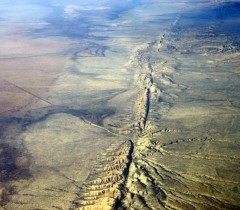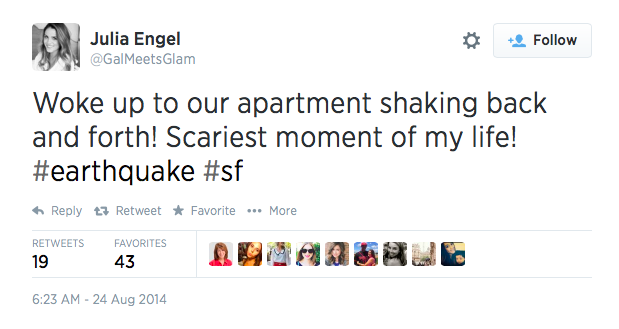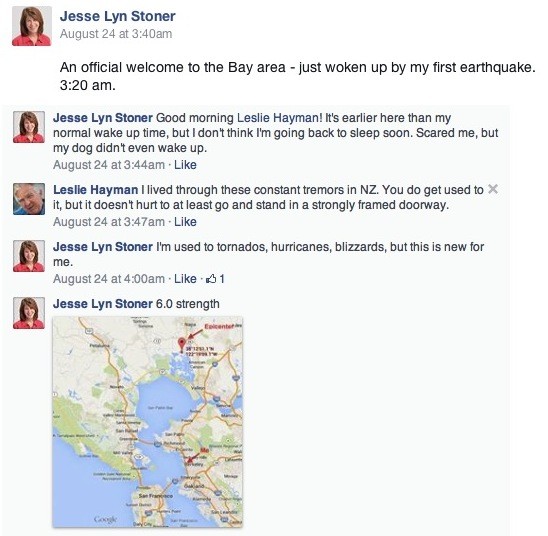 We moved from New England to the San Francisco Bay Area in the end of July. Three weeks later, I was awakened in the middle of the night by the largest earthquake in 25 years.
We moved from New England to the San Francisco Bay Area in the end of July. Three weeks later, I was awakened in the middle of the night by the largest earthquake in 25 years.
It felt like the house was right next to a train track and a train was going by. The vibration lasted about a minute and then stopped as suddenly as it had started. No one else in my house stirred, not even the dog. So it couldn’t be too serious, right?
Out of curiosity, I rolled over and typed “san francisco earthquake” on my smartphone. To my astonishment, an announcement popped up “San Francisco Earthquake 6.0 Magnitude – 2 minutes ago.”
People who live in California are used to earthquakes, but this was my first, and I had no frame of reference for understanding the significance, whether I was in danger, or what I should do. I needed information, but clicking around the Internet, I found none. It had only been 2 minutes, and the news hadn’t been written yet.
Now wide awake, I opened Twitter, typed “earthquake” and fortunately was immediately flooded with a stream of information – people reporting on their experiences with pictures attached, some asking the same question as me “What just happened? Was that an earthquake?” Others who were closer to the epicenter, reporting in on their experiences, many with pictures attached. Local news reporters jumped on sharing maps of the epicenter and affected areas.
Within 10 minutes, while the news reporters were still gather information and writing stories, I had a wealth of information.
I learned the area where I live had not been seriously affected, that I was safe, and there was no need to do anything. There might be aftershocks, but they would be milder than the original.
Having gotten the information I needed, I then hopped over to Facebook to share with people who might be concerned about me. 
All this within 20 minutes of the earthquake, while the “news stories” were still being written.
Redefining Breaking News
Although I have been active on Twitter for several years and have appreciated the ability to connect with others around leadership and related topics, I had not used it as a news source before. I went to Twitter for news on the earthquake because I couldn’t find any elsewhere. I was surprised and delighted to discover the power of real-time, direct source reporting.
It occurs to me that just as CNN redefined network news in the 1980’s, social media is now redefining it once again. When we need instant information, it’s available to us directly without having to wait for someone in the middle to interpret or filter it.
Are you taking social media seriously? Traditional forms of news media are. Even National Geographic quoted Twitter as a credible news source in its report of the earthquake.
Two years ago, Mashable asked “Are Social Networks the Media Companies of the Future?” So I guess I’m a little late to the party. And if you’re not familiar with Twitter, you might be missing it altogether. My recommendation is: it’s time to take Twitter seriously. The world has gone social and if you haven’t, you will be left behind.
Social Media News Outlets vs. Traditional News
Note from Jesse: This post is in honor of the release of the excellent new book by my friends and colleagues Ted Coiné and Mark Babbitt: A World Gone Social: How Companies Must Adapt to Survive.














I’m glad you’re OK. A few years ago in Virginia I felt my first earthquake and had no idea what to do. I headed to a room without windows with my kids thanks to Twitter too. I’ve turned to Twitter more and more as the place for breaking news. However, this week’s silly story about Betty White “dying” at home shows that people quickly make a story go viral when all they look at is the headline!
Here’s to seeing how social media continues to evolve!
Best,
Alli
Hi Alli, You raise an excellent point about how easy it is for misinformation to go viral. I think a major part of the evolution of social media will be that consumers will have to develop an active mindset around information. We are used to being fed information by news sources that has already been verified. That mindset doesn’t work when you are getting unfiltered information.
Another thought that you sparked for me was around the evolution of social media. It’s so new and is evolving so quickly. It seems like evolution itself is evolving – speeding up. Much thanks for your insightful comments!
You bring up a great illustration. After the Boston bombing I used twitter to get an eye witness account of one of the police encounters with the brothers, and since then have used it to find the latest on what’s happening in Ukraine. It’s instantaneous and unfiltered by editor’s which helps give you perspective.
Thanks for sharing your experience, David, I think that’s the key – that it is instantaneous and unfiltered. It’s especially helpful for breaking news before people have a chance to start spinning it. In the first moments of an event, you are getting raw data, which is up to you to interpret. In my situation, it’s exactly what I needed.
What a powerful example. I used to be “the last to know” about some news since we aren’t big TV watchers. But now thanks to twitter, I find I’m much more attuned. Like Alli, I am also cautious to use a twitter explosion as the lead to dig elsewhere to verify.
Hi Karin, Thanks for weighing in here, and also reinforcing the point that we need to be responsible news consumers and do our own verifications.
Right on! As an elder, I’ve gotten lazy about the latest new way of communicating. But I realize that it’s not just my grandchildren’s lives that I am missing. It’s a lot bigger than that.
I applaud your openness, Betsy. I think a lot of elders find it easier to simply dismiss social media than to dig in and understand it.
Hi Jesse
I am a new Twitterer…and so far am focused upon putting out the message of sustaining the fundamentals of leadership. You have now discovered real time events as they unfold…absolutely great from a safety perspective….if it had been a tragedy in the making Social media would have saved countless lives no doubt. Equally it can infectiously spread good news to lift our spirits…so peeps continue or start socialising. Happy Days Raymond
Welcome to a fascinating new world, Raymond. Thanks for pointing out its power to not only educate and inform, but also to inspire and life our spirits.
Hi Jesse,
So pleased you are OK. What a great post, spoken from your personal experience, and highlighting the positive side of technology. There are some bad aspects to be sure .. yet this is one the best advantages.
Stay safe and congrats on your move!
Kate
Hi Kate. I appreciate your kinds words. Thanks for stopping by!
I remember my first earthquake when I lived in SF. It took a while for my brain to connect the dots; it was over before I realized, “Oh, that is what an earthquake feels like.” I love watching how my brain works real time, especially the process of recognizing something new. I AM SO GLAD it was minor and you and all of my family in the SF Bay area and Sonoma County are fine. I also appreciate that I can find out how they are through Facebook (none of them are on Twitter yet). I hope you are still glad you made the move!
That’s exactly what happened to me. There was a part of me curiously observing my disorientation. I think that’s why I didn’t just roll over and go back to sleep. The drive to understand is a motivating force.
Facebook is definitely the place to check in on friends. I don’t think Twitter would be helpful for that. ps. Loved your pictures of Zion!
Hi Jesse, I grew up south of the Bay Area, and still remember what it’s like living on a fault line and a 6.1 is a good shake!
Reading about your experience and your insights on the utilization of social media for the transmission of serious news reminded me of “pointillissm” – art created using only dots on a page. Each individual dot reveals very little but when joined by thousands of others – beautiful pictures emerge.
Best regards,
Carl
@SparktheAction
p.s. from experience I can tell you, that won’t be your last quake, remember the northern California mantra: Duck, Cover, and Hold On
Pointillism – that’s a perfect way to describe how the information stream from Twitter quickly coalesces into a picture of what’s happening. Thanks for that excellent metaphor, Carl.
And thanks also for your advice. Hoping I won’t need to use it for awhile.
Since you are my marvelous mentor for Twitter (and I am learning so much and remembering so little), I really felt a jolt of “ah-ha” about yet another way to use this medium. It never occurred to me that I could instantly find information. It is also amazing that people n the earthquake area instantly grabbed their phones and started tweeting.
As stated above, however, there’s more to know than what 140 characters can relay. I just found out that the dictum of “duck” which use to mean stand under a door frame is now wrong. Instead, it’s to crouch under a heavy table or desk. Here, Jesse, is your latest news to keep you safe! http://www.consrv.ca.gov/index/Earthquakes/Pages/qh_earthquakes_what.aspx
Thanks for writing.
What I especially appreciate about Twitter is that it’s a “giving” environment. The point is to share information that will be helpful to others. (Those that spend their time self-promoting are ignored). It’s truly an amazing environment and I, too, am still learning about its potential. As you and others have rightly pointed out, as with all powerful tools, it’s how we use the tool that makes the difference between whether it is beneficial or a detriment. Thanks also for sharing the latest earthquake info. I will study it carefully and you can quiz me soon 🙂
I do find twitter amazing from a real time experience perspective. It also has taught me to be a little bit more discerning in how I take in information as the problem is twofold; 1.) As the story unfolds and it’s been reported on, “the facts will change”, 2.) There are some “crazies” who want to misinform in order to get attention hence spreading rumours like people dying. Twitter is famous for inaccurate RIP claims.
The good thing is it has meant me researching more, rather than just taking information I am fed at face value.
The world today is data rich, but navigate with caution as it is information poor. I am glad you were ok.
Thanks for weighing in, Thabo. I agree that the burden is on us to sift through the data and turn it into information, rather than just jumping on the bandwagon.
It seems to me that the best information is breaking news, where lots of people are simply reporting their first-hand experience, before anyone has time to put a spin on it. As the reports come in, you begin to see the patterns and picture, at least that’ s what happened in my recent experience.
Love your observation that the world today is “data rich and information poor.”
Jesse, glad you’re alright. It is a frightening thing to be involved in an earthquake in California. My father was on top of a newly constructed restaurant when he saw the horizon pitch one afternoon. He felt totally helpless. At least in a hurricane or blizzard we can seek some sort of shelter.
I live in New England but spent eight years in California. interestingly, I have experienced more earthquakes in New Hampshire (3) than in Los Angeles (2). But the ones in New England were tiny compared to SoCal’s tremors.
anyway, great post on social media, and you are so on-point on the way it is shaping news. What is an added blessing is the way people can quickly reach out during times of crises like these – an added blessing we must not forget about.
Thanks for your good wishes and sharing your own experience, Paul. It is a blessing indeed – that we can quickly and easily reach out and connect during times of crises. I suspect that in the near future, people will come to take it for granted. But living now during this transition, it is simply remarkable.
Jesse,
Really glad you are okay. I have a cousin in the bay area and as soon as I heard about the quake, I pinged him on Whatsapp. It seems he slept through the quake.
Twitter has become the medium of choice for “Citizen Journalists”. Take a look at this 2008 quake in China. It is said that the first reports and photos came through Twitter.
http://www.telegraph.co.uk/news/worldnews/asia/china/1950212/China-earthquake-brings-out-citizen-journalists.html
Social media has become a powerful way of communicating almost instantly and reaching the greatest number of people across the globe. However as many of the commenters and you yourself have pointed out, this comes with its own baggage.
In summary, this saying holds good for social media – With great power comes great responsibility!
Take care!
Thanks for your comments and for sharing the 2008 article Sudhir, I read it with interest. I was struck by two things –
1) I am indeed late to the party, but there are a lot more people who are later than I am. And 2) that traditional media considers it a viable news source.
Both of which underscore the significance of this phenomenon – it is a powerful force and an especially helpful news source during a crisis.
However, as you also point out, it is raw data, and the burden of proof is on us.
Welcome to the west (best) coast, Jesse! Now that you are closer, hope we get the chance to meet in person someday. Bret
Thanks, Bret. It would be a pleasure!
Enjoying your blog, and glad to hear you are ok after the earthquake. When we survived the Loma Prieta quake in ’89, I remember being unnerved because I was not able to do anything about what was happening. It just shows up unannounced and happens.
I’ve been part of the twitter community (@michaellanghout) from close to the beginning, and now take much of my news from my twitter feed. I use hootsuite to manage all tweets and blog posts. It might be a useful tool for you as you dive deeper into social media.
Thanks, Michael. I’ve been hearing stories of the ’89 earthquake and fortunately the effects of this earthquake were not as severe where I live. But still it was indeed unnerving. Looking forward to connecting with you on Twitter!
Just remember, your Twitter feed is only as good as who you choose to follow. Twitter is my go-to platform for when news breaks but always be careful, misinformation can he an issue.
@madnewsboy, Madison, Wis
Good point, Barry. Because I wanted to hear from people who were talking about the earthquake, not only those who were following me, I typed “earthquake” in the search box instead of looking at my Twitter feed. I found it helpful for breaking news where people are just sharing information about their own experience. The pattern gives you the picture. Where we get into trouble is depending on others to put their interpretation on the data for us, especially if we only listen to people who see it the way we do.